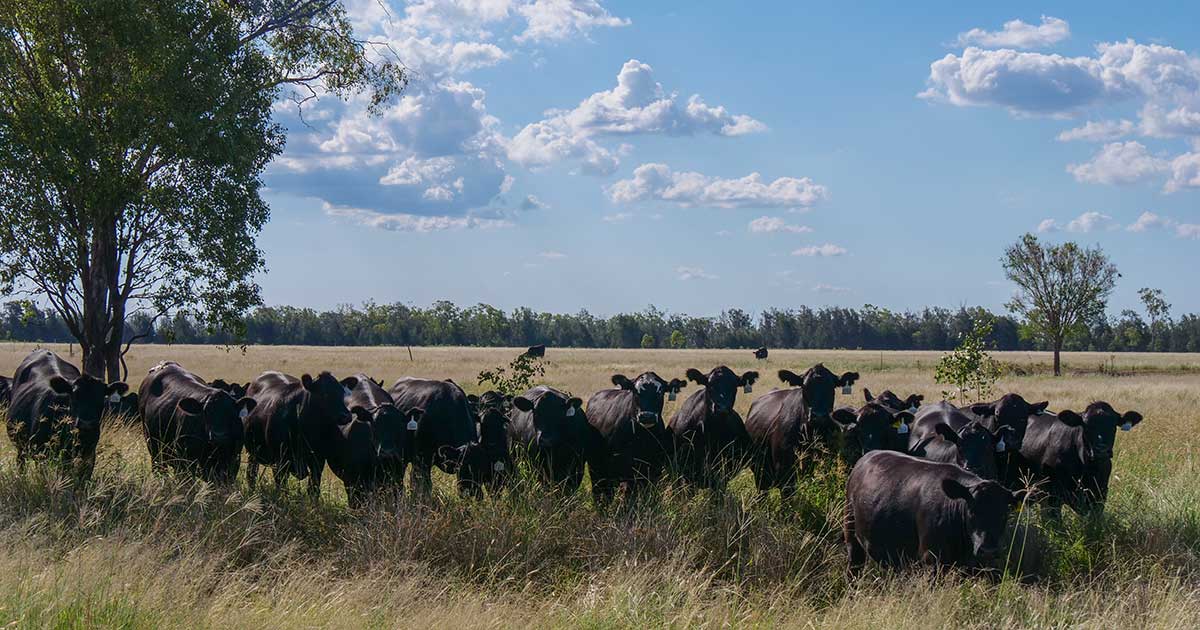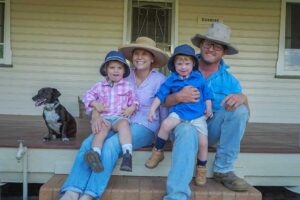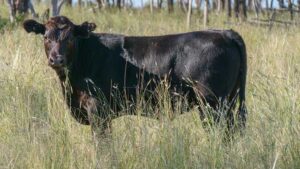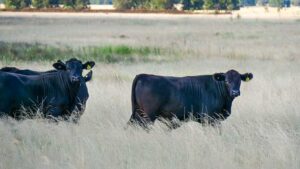Fertile and functional breeders for the environment


Located in the Dunmore district in the Darling Downs region of Queensland, Dunmore Pastoral is a mixed farming operation spanning across three properties.
Made up of parents Ralph and Von Clay, son Tim and his wife Gemma and daughter Annie Webb and her husband Fraser, Dunmore Pastoral is a family operation, running an Angus and Angus influenced steer backgrounding enterprise and breeding operation.
Further to the beef enterprises, the operation also farms country with dryland and irrigated multi-species fodder cropping.
 General Manager of Dunmore Pastoral is Tim Clay, who returned to the family operation in 2014 following a period of time working in the northern Australia cattle industry.
General Manager of Dunmore Pastoral is Tim Clay, who returned to the family operation in 2014 following a period of time working in the northern Australia cattle industry.
“I grew up at “Prospect” and did a year after school working for Consolidated Pastoral Company (CPC) at Newcastle Waters Station in the Northern Territory (NT),” said Tim.
“I went to Marcus Oldham from 2010 – 2013 doing a Bachelor of Farm Management.
“Following this I did a year as an Operation Analyst for CPC in 2014, travelling throughout the Kimberly, NT and Cape York working on ways to improve station performance.
“I came home at the end of 2014 when we purchased “Dunmore” from my cousin in a farm management role. In 2020 my sister and brother and law came on to manage a new property we purchased (“Remilton”) and we created a role for a General Manager in the business, which I filled and have been doing ever since.”
The Dunmore Pastoral business is made up of three locations, the “Prospect”, “Dunmore” and “Remilton” properties.
Located in the Dunmore locality, “Prospect” and “Dunmore” cover 4,800 hectares of owned country, on Black and Grey Brigalow, Box and Belah soils and 3,200 hectares of leased lighter textured forest breeding country. On these two properties, Dunmore Pastoral runs 500 Angus breeders and 1,200 backgrounder steers and heifers.
The rest of their operation is run on “Remilton” 100km further west in the district of Westmar. Made up of Brigalow and Belah soils with some red Box country, “Remilton” is home to some 800 backgrounder steers.
Angus was originally introduced into the family’s operations in the early 1990’s.
“Angus bulls were first purchased in the early 1990’s to put across first calf Hereford heifers due to their ease of calving,” said Tim.
“The family had originally had Herefords but by the mid 2000’s there was a strong Angus influence,” he continued, “Most females are now completely black but there are still some legacy broken baldys within the cow herd.
 “We have found these crossbred cows to be highly fertile and functional, especially running on the lighter country. There is also a small percentage of cows with some bos indicus content from heifers purchased following the 2019 drought.”
“We have found these crossbred cows to be highly fertile and functional, especially running on the lighter country. There is also a small percentage of cows with some bos indicus content from heifers purchased following the 2019 drought.”
When it comes to the adoption of Angus genetics within their breeding system and the reasonings behind this transition, Tim said, “Primarily Angus are fertile and functional breeders for our environment.
“Secondly the integrity and repeatability of data for the use in breeding decisions is unparalleled to other breeds.
“Thirdly the marketing has been backed up by a quality product that people want, that we can produce for a premium with no sacrifice to cost of production.”
Primary to the Dunmore Pastoral business is their steer backgrounding enterprise, which contractually supplies progeny to Mort & Co.
 Through this part of their business, Dunmore Pastoral supplies pure bred Angus steers for the Mort & Co 200-day grain fed program, used in the production of the company’s branded Angus beef products. For this market, steers are turned off for feedlot entry at 380kg-500kg, HGP free, with milk- 2 teeth.
Through this part of their business, Dunmore Pastoral supplies pure bred Angus steers for the Mort & Co 200-day grain fed program, used in the production of the company’s branded Angus beef products. For this market, steers are turned off for feedlot entry at 380kg-500kg, HGP free, with milk- 2 teeth.
Additionally, the operation also supplies cross bred steers to the Mort & Co 100-day grain fed program. Similarly, the market specifications for these animals are 380 – 500kg at entry, HGP free, Milk – 2 teeth, with under 51% Tropical Breed Content.
In 2024, the family will look to supply approximately 2,500 steers into Mort & Co’s Grassdale and Pingrove feedlots through this contract. The herd also participates in MSA grading.
When it comes to their breeding operation, the family joins 500 females annually, with approximately 80 heifers retained each year back into the herd.
Heifers are joined at 14 months and 350kg+. Bulls are put out for joining in January for a 90-day period, running at one bull per 50 females.
Following the joining period, females are pregnancy tested to a nine-week window, with any empty females falling out of this period culled from the mob. Dunmore Pastoral has an average conception rate of 94%, with an average weaning rate of 90%.
In the lead up to, during and after joining, nutrition is a focus in the management of the animals.
In regards to management practices applied during this time, Tim said, “We are mainly matching timing of mating with feed quality.
“Bulls are put into the paddock on the 1st of January, and this lines up with the following year to match peak lactation around January or February with the best chance of receiving reliable rainfall and therefore pasture quality and quantity,” he said.
“Lick is also made available all year round to maintain performance.”
To maintain genetic improvement and productivity within their herd, females are cast for age at eight years old. Furthermore, females are culled from the herd typically based on fertility, structure and temperament.
“Any female coming in at branding or weaning without a calf is culled,” said Tim.
“Any cow that is preg tested empty after weaning is culled. Heifers are culled on phenotype, weight for age (maturity) and temperament.”
He continued, “All cull vendor bred heifers are taken through to a joining weight of 320-350kg and generally marketed through AuctionPlus as future breeders for other producers.”
 When selecting sires for their herd, the family combines genomic information and phetoype to make their selection decisions for their commercial operations.
When selecting sires for their herd, the family combines genomic information and phetoype to make their selection decisions for their commercial operations.
“Generally, at a sale we don’t look at bulls under the 25th percentile for the Angus Breeding Index,” said Tim.
“Calving Ease needs to be positive; Mature Cow Weight is under +110, better than average growth figures and Birth Weight is under +5.”
Structurally, Tim highlights bulls must be, “Appealing to the eye, with an even back line and underline and thick rump.
“We think there could be good bulls outside of these parameters but if we are preparing to pay $15,000 – $20,000 for a herd bull everything needs to stack up,” he said.
“If you’re trying to be in the top 25% of the breed there’s no point looking at bulls in the bottom 50%.”
The business has also utilised fixed time artificial insemination within their breeding herd in order to take advantage of sires that which meet their desired selection criteria, however, were priced out of their market. These programs were a success for the operation, with a 60% pregnancy rate achieved.
Applying a no passengers approach to ensure success within their operations, Dunmore Pastoral theorises that every female must be productive, and if she’s not that animal becomes tradable to provide an income stream.
Sustainability and productivity continue to be at the forefront of Dunmore Pastoral, with several areas of innovation being introduced into the business in order to make changes that benefit the overall efficiency of the operations being run by the Clay and Webb families.
When it comes management practices and philosophies applied within their business, Dunmore Pastoral utilises feed budgeting through matching stocking rates to carrying capacity, an area of development introduced to the business four years ago.
“We budget out feed from the end of the growing season in March and budget through to December,” said Tim.
“We input this data into Maia Grazing to help guide our decision making. We also systemise as much as possible.”
Feed budgeting has been a beneficial area of development for the business and its growth since they began its implementation.
“Since we started feed budgeting and rotational grazing four years ago, we have not had to force sell any animals and we have maintained constant grass ground cover, even in a decile 1 rainfall year in 2023,” said Tim, “We have seen it be more financially rewarding as well.”
Furthermore, the company has been utilising the Optiweigh system within their operations, which Tim emphasises as a ‘gamechanger’ for their business.
“We now do less yard work and check weighing, which means there is less stress to the animals,” said Tim.
“The Optiweigh operates 24/7 365 days of the year, and we book all of our consignments using the data from it.
“Cattle are mustered, yarded, weighed, and trucked all within 24 hours and we know that they are within 5kg’s of what they would weigh at the feedlot two weeks before we get them in.
“The added benefits are we know when they might be getting sick for example with three day or which paddocks put more weight on than others and also knowing the cost of mustering in terms of shrink etcetera.”
With sustainability a mainstay topic within the industry, the family have also trialled and implemented some environmental adaptions in their business through the use of biosolids as a fertilizer for their pastures.
“We were hesitant at first to use biosolids due to the odour and reports of potential contamination materials present in biosolids, but after a great deal of research and partnering with a company call Top Soil Organics in 2021, we could see their testing regimes and integrity around how it is applied to the paddocks was very tight,” said Tim.
 “Soil samples are taken pre-application to determine the appropriate application rates and then taken again thereafter to monitor any elevated levels, which we so far, we have not seen.”
“Soil samples are taken pre-application to determine the appropriate application rates and then taken again thereafter to monitor any elevated levels, which we so far, we have not seen.”
This innovation has proved a beneficial one, not only for their business, but through recognising the implications such progression can have for environment in general.
“Compared to other organic fertilisers the response in pasture quantity and quality is unbeatable and likewise with cattle performance,” he continued, “We see it as a great way of completing the food cycle.”
“It is a lot better way of using the product than putting it into landfill and pumping it into the ocean.”
In 2023, Dunmore Pastoral opened their gates to the Angus Foundation Neogen Production Tour, which saw eight participants, all young members of the beef industry from around Australia, converge on farm, visiting Dunmore Pastoral and observing their day-to-day operations, with Tim as their guide.
With the emphasis on growth and productivity that is evident within the operations at Dunmore Pastoral, it is not surprising to see that for Tim, opening his operations to the visitors was a mutually beneficial opportunity to learn more from other members of the beef industry.
“The main benefits I saw from being a stop on the tour is hopefully they can take something away from what they have seen in our business and successfully implement that in their operation,” he said.
 “Likewise, I think it was great for us to have to answer questions thrown at us that we may not have asked ourselves and potentially think about what we need to do differently as well.”
“Likewise, I think it was great for us to have to answer questions thrown at us that we may not have asked ourselves and potentially think about what we need to do differently as well.”
Looking to the future of Dunmore Pastoral, strategic planning is an important element of their day to day, with goals already in place for further development and expansion for their enterprises.
“Our primary strategic goal is to get to a 5,000AE carrying capacity in the next 6 -7 years,” said Tim.
“This will be achieved through a combination of purchasing and leasing more country and improving the current area we hold.”
Cheyne Twist, Senior Marketing & Communications Officer